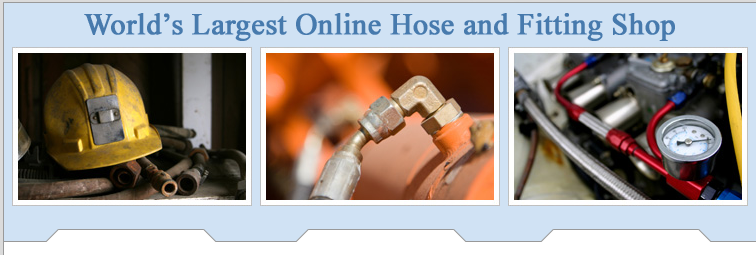What is a NPSM Thread and How Does it Work?
If you want to ensure the smooth operation and safety of your equipment, it goes without saying that you need to have the right components. After all, if you’re working in an industry where every detail counts - as so many of us are - you need to make sure you explore each and every technical aspect.
A common question asked here at Hose and Fittings is, “what is a NPSM thread?”
In this post, we’ll explain the NPSM and NPT meaning - and break down the differences between the two for you as well.
What is NPSM Thread?
NPSM, which stands for National Pipe Straight Mechanical thread, follows a standardized threading pattern, much like its cousin, NPT (National Pipe Thread).
However, NPSM threads are unique due to their straight-grain, non-tapered design, which distinguishes them from the conical profile of NPT threads.
NPSM is the American standard for threads used on fittings and pipes in plumbing and specific mechanical applications. NPSM threads, again, are straight threads designed to create a seal through the use of a gasket or washer rather than relying on the threads themselves for sealing. These threads most often tend to be found in fluid handling systems where a tight, leak-resistant connection is absolutely essential.
What Are Some Common NPSM Thread Characteristics? Here are a few more characteristics (and benefits) of NPSM threads to pay attention to:
Straight-Grain Design and Versatility
An NPSM thread’s straight-grain design allows for easy installation and removal, typically requiring fewer turns than NPT threads, leading to quicker assembly.
This characteristic makes NPSM threads suitable for applications that call for a quick, convenient connection without necessitating an extensive sealing process.
Ideal for Low-Pressure Systems
NPSM threads’ sealing performance is not as robust as NPT threads, as their design doesn't lend itself to creating a high-pressure seal. This makes NPSM threads excellent for low-voltage, non-exacting applications such as lighting fixtures, domestic appliances, and non-critical mechanical connections.
Widespread Application
Despite their reduced sealing capability, NPSM threads have a significant presence across various sectors.
Whether it’s lighting or home appliances, mechanical connections, or certain low-pressure pipeline applications, the NPSM thread is there to help, offering a route to establishing connections that are efficient and adequate for their specific contexts.
Where is NPSM Thread Used?
So what settings might NPSM thread be useful for?
To start, they’re common in the lighting industry, where they offer a sturdy installation as well as a safe, reliable electrical joint.
They can also be used in household equipment. Whether in faucets, bathroom fixtures, or home appliances, NPSM threads serve as the unobtrusive link to connect different components within equipment.
Mechanical engineering benefits extensively from the utility of NPSM threads, too. These play a crucial role in connecting pipes, valves, and sensors.
Finally, in industrial settings, NPSM threads are a common sight. They’re a key part of the compressed air systems, cooling installations, and all kinds of industrial piping setups. They offer some level of convenience while also still meeting the stringent sealing requirements of certain applications - truly, the best of both worlds.
What is the Difference Between NPSM and NPT? When it comes to the difference between NPSM and NPT, the devil truly is in the details.
The most recognizable difference between the two lies in the thread’s taper. NPT threads feature a tapered design for enhanced sealing, especially in high-pressure applications, while NPSM threads are straight-grained and suitable for low-pressure systems.
There’s also some differences in how they’re installed. Because of their respective designs, NPT threads demand more turns during the installation process to ensure a tight, effective seal,
whereas NPSM threads achieve the ideal connection with significantly fewer turns because of the straight-grain texture.
In high-pressure or high-sealing scenarios, NPT threads reign supreme due to their sealing capabilities. NPSM threads aren’t as ideal for these situations, but can perform just fine in settings that don’t require extensive sealing.
Finally, NPT threads are ideal for gas and liquid transmission systems, as well as pipe connections and, as mentioned earlier, other high pressure applications. NPSM threads are better for applications that don’t involve high pressure, like lamps and household equipment.
Choosing the Right Pipe Threading
Deciding whether to use NPSM or NPT threads isn’t necessarily a matter of personal preference, but of the task at hand. There are a few factors you’ll want to consider when deciding which is best.
First, you need to understand the level of pressure and the sealing requirements of the job at hand. If you’re working on a high-pressure system, NPT is ideal. If it’s a low-pressure system where ease of assembly is a top priority, go for NPSM.
If you’re on the hunt for a thread that offers exceptional sealing and a longer lifespan for your equipment, NPT might be the better choice, but if you value quick, hassle-free connections, NPSM will be the way to go.
Ultimately, you’ll want to keep close tabs on industry standards and the thread types most commonly used in your sector. This can help you streamline your supply chain and maintenance processes. Assess the availability of fittings with your chosen threading type, too - some of this decision might end up hinging on supplier and market viability.
Still can’t decide? Don’t be afraid to reach out for help. Here at Hose and Fittings, we’re happy to answer any questions you have to make sure you find the perfect fit on a case-by-case basis. Whether it’s NPSM, NPT, or any other acronym you have questions about, it would be our pleasure to help walk you through the process.
Check out our selection today!

